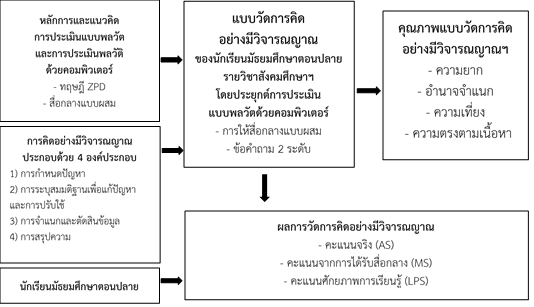Development of Critical Thinking Scale of Upper Secondary School Students in Social Studies by Applying Computerized Dynamic Assessment
DOI:
https://doi.org/10.14456/educu.2024.18Keywords:
computerized dynamic assessment, mixed prompting, critical thinkingAbstract
The purposes of this pilot study were 1) to develop the critical thinking scale of upper secondary school students in social studies by applying computerized dynamic assessment, and 2) to validate the critical thinking scale of upper secondary school students in social studies by applying computerized dynamic assessment. The sample consisted of 100 upper secondary school students by purposive sampling. The research instrument used was the critical thinking scale by applying computerized dynamic assessment. Data were analyzed by using content validity, item validation including the difficulty and discrimination indexes, and internal consistency in terms of Cronbach’s alpha coefficient. Results revealed that 1) the critical thinking scale by applying computerized dynamic assessment was two-tier multiple-choice tests (20 items) measuring four components; (1) problem formulation, (2) hypothesis identification and application, (3) data classification and judgment, and (4) conclusion. 2) All items and mixed prompting had content validity (IOC index = .8 to 1.0 and .6 to 1.0), the difficulty and discrimination indexes = .45 to .82 and .41 to .82, and Cronbach’s alpha coefficient = .88.
References
ภาษาไทย
กรมวิชาการ. (2540). การออกแบบและพัฒนาการวัดกระบวนการคิด. คุรุสภาลาดพร้าว.
ญาณิกา ลุนราศรี. (2563). การวัดการรู้เรื่องการอ่าน พัฒนาการและศักยภาพการเรียนรู้ของนักเรียนชั้นมัธยมศึกษาปีที่ 3: การประยุกต์แนวคิดการประเมินแบบพลวัตด้วยคอมพิวเตอร์ [วิทยานิพนธ์ปริญญาดุษฎีบัณฑิต, จุฬาลงกรณ์มหาวิทยาลัย]. Chulalongkorn University Intellectual Repository (CUIR). http://cuir.car.chula.ac.th/handle/123456789/76657
บุญใจ ศรีสถิตนรากูร. (2555). การพัฒนาและตรวจสอบคุณภาพเครื่องมือวิจัย: คุณสมบัติการวัดเชิงจิตวิทยา. สำนักพิมพ์แห่งจุฬาลงกรณ์มหาวิทยาลัย.
วิเชษฐ์ แสงดวงดี. (2557). การพัฒนารูปแบบการเรียนการสอนแบบผสมผสานด้วยแนวคิดการเรียนรู้โดยใช้ปัญหาเป็นฐานและการคิดอย่างมีวิจารญาณเพื่อเสริมสร้างความสามารถในการตัดสินใจทางจริยธรรมในวิชาชีพวารสารศาสตร์ [วิทยานิพนธ์ปริญญาดุษฎีบัณฑิต, จุฬาลงกรณ์มหาวิทยาลัย]. Chulalongkorn University Intellectual Repository (CUIR). http://cuir.car.chula.ac.th/handle/123456789/45381
ศิริชัย กาญจนวาสี. (2556). ทฤษฎีการทดสอบแบบดั้งเดิม (พิมพ์ครั้งที่ 7). สำนักพิมพ์แห่งจุฬาลงกรณ์มหาวิทยาลัย.
สำนักงานคณะกรรมการการศึกษาขั้นพื้นฐาน. (2551). ตัวชี้วัดและสาระการเรียนรู้แกนกลางกลุ่มสาระการเรียนรู้สังคมศึกษา ศาสนา และวัฒนธรรม. https://drive.google.com/file/d/0B9t56k6dmUe5Z202Wmw5S1dvOGM/view?resourcekey=0-5dzEmHF7yipsPKfkZShqjw
สำนักงานคณะกรรมการการศึกษาขั้นพื้นฐาน. (2564). สมรรถนะคิดขั้นสูง.
https://drive.google.com/drive/folders/13jiasd1lle3kMHSiACIqBa7ClqqiiQK4
อรพิณ พัฒนผล. (2551). การพัฒนาแบบทดสอบวัดความสามารถในการคิดอย่างมีวิจารณญาณสำหรับนักเรียนช่วงชั้นที่ 3 โรงเรียนมัธยมศึกษา สังกัดสำนักงานเขตพื้นการศึกษานครสวรรค์ เขต 1 [วิทยานิพนธ์ปริญญามหาบัณฑิต, มหาวิทยาลัยศรีนครินทรวิโรฒ]. ThaiLIS sss Digital Collection Working Group (TDC). https://tdc.thailis.or.th/tdc/browse.php?option=show&browse_type=title&titleid=467081
ภาษาอังกฤษ
Cacchione, A. (2015). Creative use of Twitter for Dynamic Assessment in Language Learning classroom at the university. IxD&A, 24, 145-161. https://doi.org/10.55612/s-5002-024-009
Chang, C. Y., Yeh, T. K., & Barufaldi, J. P. (2010). The positive and negative effects of science concept tests on student conceptual understanding. International Journal of Science Education, 32(2), 265-282. https://doi.org/10.1080/09500690802650055
Clifford, J. S., Boufal, M. M., & Kurtz, J. E. (2004). Personality traits and critical thinking skills in college students: Empirical tests of a two-factor theory. Assessment, 11(2), 169-176. https://journals.sagepub.com/doi/pdf/10.1177/1073191104263250
Decaroli, J. (1973). What Research Say to the Classroom Teacher: Critical Thinking. Social education, 37(1), 67-69.
Dressel, P.L., & Mayhew, L.B. (1957) General Education: Explorations in Evaluation (2nd ed.). American Council on Education.
Ennis, R. H. (2005). Supplement to the test/manual entitled the Ennis-Weir critical thinking essay test. Urbana: Department of Educational Policy Studies, University of Illinois at Urbana–Champaign.
Gagne′, R. M. (1985) The Conditions of Learning and Theory of Instruction. CBS College Publishing.
Gliem, J. A., & Gliem, R. R. (2003). Calculating, Interpreting, and Reporting Cronbach’s Alpha Reliability Coefficient for Likert- Type Scales. Midwest Research to Practice Conference in Adult, Continuing, and Community Education Calculating, 14(C), 82–88. http://pioneer.chula.ac.th/~ppongsa/2900600/LMRM08.pdf
Gurel, D., Eryilmaz, A., & McDermott, L. (2015). A review and comparison of diagnostic instruments to identify students' misconceptions in science. Eurasia Journal of Mathematics Science and Technology Education, 11(5), 889-1008. https://doi.org/10.12973/eurasia.2015.1369a
Halpern, D. F. (2013). Thought and knowledge: An introduction to critical thinking (5th ed.). Psychology Press.
Kozulin, A., & Garb, E. (2002). Dynamic assessment of EFL text comprehension. School Psychology International, 23(1), 112-127. https://doi.org/10.1177/0143034302023001733
Lawshe, C. H. (1975). A quantitative approach to content validity. Personnel psychology, 28(4), 563-575. https://caepnet.org/~/media/Files/caep/knowledge-center/lawshe-content-validity.pdf
Lidz, C. S. (1995). Dynamic Assessment and the Legacy of L.S. Vygotsky. School Psychology International, 16(2), 143-153. https://doi.org/10.1177/0143034395162005
Lidz, C. S. (2003). Early childhood assessment. John Wiley & Sons.
http://ndl.ethernet.edu.et/bitstream/123456789/50260/1/Carol%20S.%20Lidz.pdf
Milenkovic, D. D., Segedinac, M. D., Hrin, T. N., & Horvat, S. (2016). The impact of instructional strategy based on the triplet model of content representation on elimination of students’ misconceptions regarding inorganic reactions. Journal of the Serbian Chemical Society, 81(6), 717-728.
https://www.shd-pub.org.rs/index.php/JSCS/article/view/984/216
Moseley, D., Baumfield, V., Elliott, J., Gregson, M., Higgins, S., Miller, J., & Newton, D. P. (2005). Frameworks for thinking: a handbook for teaching and learning. Cambridge University Press. https://dro.dur.ac.uk/1907/1/1907.pdf?DDD29+ded4ss
Nunnally, J. C. (1978). Psychometric theory (2nd ed.). McGraw-Hill.
Poehner, M. E., & Lantolf, J. P. (2005). Dynamic assessment in the language classroom. Language Teaching Research, 9(3), 233-265. https://doi.org/10.1191/1362168805lr166oa
Poehner, M. E., Zhang, J., & Lu, X. (2015). Computerized dynamic assessment (C-DA): Diagnosing L2 development according to learner responsiveness to mediation. Language Testing, 32(3), 337-357. https://doi.org/10.1177/0265532214560390
Polit, D. F., & Beck, C. T. (2006). The content validity index: are you sure you know what's being reported? Critique and recommendations. Research in nursing & health, 29(5), 489-497. https://onlinelibrary.wiley.com/doi/epdf/10.1002/nur.20147
Sternberg, R. J., & Halpern, D. F. (2020). Critical thinking in psychology. Cambridge University Press. http://psychnet.wustl.edu/memory/wp-content/uploads/2018/04/BC_Roediger-McCabe-2007-1.pdf
Tarricone, P. (2011). The taxonomy of metacognition. Psychology Press.
https://doi.org/10.4324/9780203830529
Taube, K. T. (1993). Critical thinking ability and disposition as factors of performance on a written critical thinking test [Doctoral dissertation]. ProQuest Dissertations and Theses database.
https://www.proquest.com/openview/2acf75dc570ac3a433bad550b8215828/1
Tzuriel, D. (2001). Dynamic assessment of young children. Kluwer Academic/Plenum Publishers. https://doi.org/10.1007/978-1-4615-1255-4
Viechtbauer, W., Smits, L., Kotz, D., Budé, L., Spigt, M., Serroyen, J., & Crutzen, R. (2015). A simple formula for the calculation of sample size in pilot studies. Journal of Clinical Epidemiology, 68(11), 1375- 1379. https://doi.org/10.1016/j.jclinepi.2015.04.014
Vygotsky, L., Piaget, J., & Kohlberg, L. (2006). The developmentalists. In H. Rom (Ed.), Key thinkers in psychology (pp. 25-44). Sage.
Watson, G., & Glaser, E.M. (1962). Watson-Glaser Critical Thinking Appraisal Manual: Form A and B. Harcout Brace and World Inc.

Downloads
Published
How to Cite
Issue
Section
License

This work is licensed under a Creative Commons Attribution-NonCommercial-NoDerivatives 4.0 International License.



